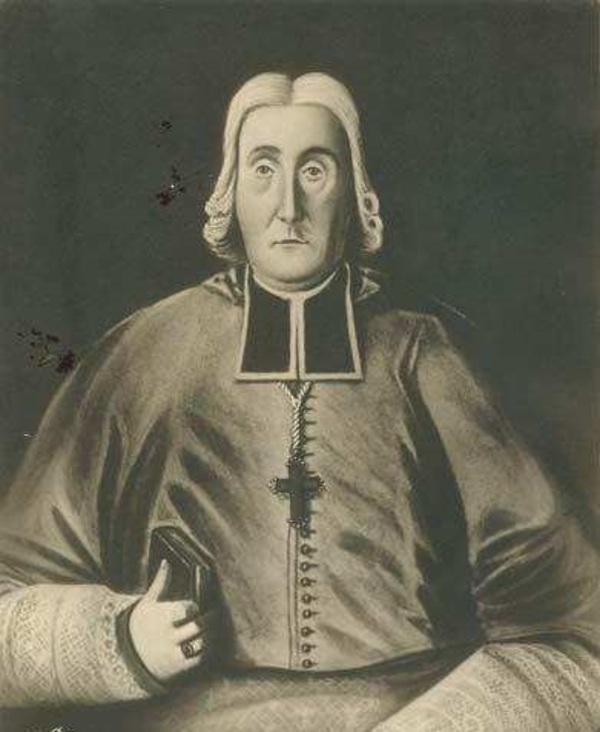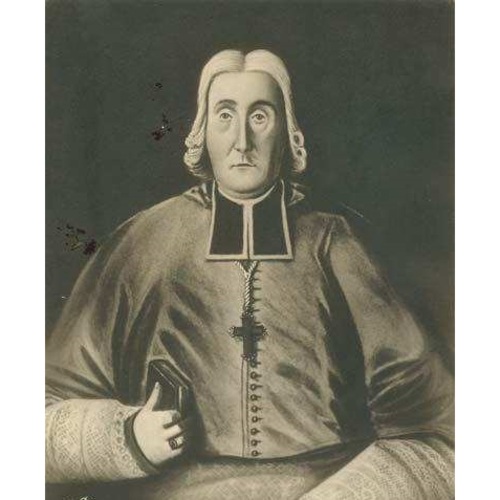
Source: Courtesy of Wikimedia Commons
MARIAUCHAU D’ESGLY (d’Esglis, Desglis; he signed Desgly), LOUIS-PHILIPPE, bishop of Quebec; b. 24 April 1710 at Quebec, son of François Mariauchau* d’Esgly and Louise-Philippe Chartier de Lotbinière; d. 4 June 1788 at Saint-Pierre, Île d’Orléans (Que.).
Louis-Philippe Mariauchau d’Esgly descended from prominent families on both his father’s and his mother’s side and at baptism had Governor Philippe de Rigaud* de Vaudreuil as godfather. Nothing is known of his childhood and education except that he entered the Séminaire de Quebec on 15 Oct. 1721. After ordaining him to the priesthood on 18 Sept. 1734, Bishop Dosquet immediately named him to the parish of Saint-Pierre, Île d’Orléans. Because of the scarcity of priests after the conquest, d’Esgly also had to minister to the neighbouring parish of Saint-Laurent virtually without a break from 1764 to 1774.
After the conquest the episcopal succession became an issue of importance. Anxious to avoid the difficulties that had surrounded his own appointment, Bishop Briand of Quebec wanted a coadjutor named as quickly as possible. Although Étienne Montgolfier appeared to be the ideal candidate, Governor Guy Carleton*, who wanted to have a Canadian in the post and was under pressure from the Lotbinière family, insisted on Abbé d’Esgly, who had, “among other merits, that of not offending anyone.” Briand was somewhat disappointed with this candidate, who was older than he and deaf as well, but he resigned himself to ratifying the choice, which had the advantage of implying that the government recognized the principle of there being a succession in the bishopric of Quebec. On 28 July 1770 Briand hastened to ask the Holy See for the necessary bulls. As he had to go to England, Governor Carleton wanted the question settled as soon as possible, and he pressed Briand to consecrate d’Esgly without waiting for Rome’s authorization. The nephews of the parish priest of Saint-Pierre also became involved; d’Esgly, amused at their eagerness, observed that they wanted “to have the pleasure of saying ‘Monseigneur, my uncle.’” Despite the pressures, Briand waited until the bulls, signed by Pope Clement XIV on 22 Jan. 1772, were received in Quebec. On 12 July he consecrated his coadjutor bishop in partibus of Dorylaeum. D’Esgly thus became the first Canadian-born bishop. Because of the dispute, dating back to 1766, between the bishop of Quebec and the churchwardens of Notre-Dame over the use of the parish church as a cathedral [see Jean-Félix Récher*], the ceremony was held “secretly, although everyone knew of it,” in the chapel of the Séminaire de Quebec. The public and official proclamation of the choice of d’Esgly was, however, delayed until March 1774. Although now coadjutor, d’Esgly insisted upon remaining in Saint-Pierre, where he continued to carry out his duties as parish priest with the help of curates. He published his only pastoral letter as coadjutor on 6 June 1778, prior to an official visit of the parishes on Île d’Orléans. In it he reproached the habitants for their sins and called upon them to make his visit the occasion for a return to virtuous living.
When d’Esgly’s health deteriorated, Briand feared that the principle of succession would again be called into question; this fear led him to resign on 29 Nov. 1784. On 2 December d’Esgly signed the act of accession to his see. On the same day he named his vicars general, confirming in office Abbé Henri-François Gravé* de La Rive at Quebec, Pierre Garreau, dit Saint-Onge, at Trois-Rivières, and Montgolfier at Montreal. In Paris Abbé François Sorbier de Villars was also reappointed as vicar general. The only innovation was the appointment of a vicar general in London, where Father Thomas Hussey, an Irish priest, was to be the bishop’s representative to the British government.
On 4 December the new bishop published his first pastoral letter. He had no illusions: in view of his age and infirmities he knew he would hold the post only briefly. He informed the faithful that they should continue to take their concerns to Briand, adding, “If his infirmities do not permit him to attend to [them], our vicar general in Quebec will settle them or send them on to us.” D’Esgly returned to his parish in Saint-Pierre on 6 Jan. 1785, even though Briand had hastened to give up to him the apartments reserved for the titular bishop at the Séminaire de Québec.
One of the new bishop’s first concerns was to find himself a coadjutor; on 22 Dec. 1784 he sent a letter to Abbé Jean-François Hubert, who was the missionary at Detroit, announcing that he had been chosen. As Rome and London were slow in approving this nomination, Hubert was not consecrated bishop until November 1786. The next year Hubert undertook a pastoral visit in the bishop’s name; there had been none following one Bishop Briand had been unable to complete in 1775, except for d’Esgly’s visit to Île d’Orléans.
As a transitional bishop, d’Esgly contented himself, in the main, with administering the diocese, rather than seeking to govern through the adoption of long-term policies. Thus he settled local disputes over the choice of new church sites at Saint-Gervais, Baie-du-Febvre (Baieville), and particularly Yamachiche. He had to resolve a few problems of ecclesiastical discipline, such as the case of the Sulpician Pierre Huet* de La Valinière. He also had to deal with the famous Baie-Saint-Paul malady, and he signed a circular letter to announce Dr James Bowman’s visit to the parishes. But the main question that concerned him, as it did his predecessor and immediate successors, was the lack of priests. The bishop wanted to bring priests from Europe to serve in the missions and teach in the colleges and seminaries, thus freeing the Canadian priests for parish ministry. Although he himself was not worried about whether the foreign priests were French, Savoyards, or Irishmen who knew French, the British government’s opposition to the French and Briand’s to the Savoyards forced him to appeal to the Irish priests, and he gave Father Hussey the task of recruiting them.
D’Esgly paid particular attention to the Maritimes, a region somewhat neglected since the conquest, where the scarcity of priests was being felt acutely. In January 1785 he confirmed Joseph-Mathurin Bourg there as vicar general. Later that year he posted James Jones*, who had arrived from Ireland, to Halifax, giving him jurisdiction over the priests whom John Butler, bishop of Cork, was sending. On 17 Oct. 1787 he sent the Catholics in the Maritimes a pastoral letter in which he congratulated them on having kept the faith, even when “mingled with foreign Protestants” and enjoying less spiritual support than the Canadians. He exhorted them to receive generously and obediently the European missionaries who had come to bring them succour.
During his final months as bishop of Quebec d’Esgly perceived that his authority, which he exercised from Île d’Orléans, was not being accorded sufficient respect and he sought to strengthen it. He reproached certain priests of the Séminaire de Québec, among them Thomas-Laurent Bédard and Gravé, for insubordination and even deprived Gravé of his authority as vicar general. He criticized Hubert, who had rather a low opinion of his superior’s abilities, for not having given him an account of his pastoral visit. Only Briand’s intervention with Hubert, recommending obedience, averted a crisis.
D’Esgly became unable to say mass in March 1788, and died on 4 June. The funeral, at which Gravé officiated, was held two days later in the church of Saint-Pierre; as d’Esgly had requested in his will, he was buried there. Nearly two centuries later, on 8 May 1969, his remains were transferred to the crypt of the basilica of Notre-Dame in Quebec. D’Esgly had not sought the office of bishop, but in accepting his elevation he made it possible for the problem of the episcopal succession to be resolved. Nevertheless, as historian Marcel Trudel has suggested, he may be criticized for having seriously complicated ecclesiastical administration by his insistence on living on his island until his death.
AAQ, 12 A, D, 54v; 22 A, IV, 545; 30 A, III, 2; 10 B, 115v, 118, 123v; 1 CB, VI, 26, 39–41, 53, 55; 61 CD, Saint-Laurent, île d’Orléans, I, 1–6. ANQ-Q, AP-P-1385; AP-P-1386; État civil, Catholiques, Notre-Dame de Québec, 25 avril 1710; Saint-Pierre, île d’Orléans, 1734–88; QBC 28, Conseil militaire, 7, 4 mars 1761. ASQ, C 35, pp.240–47; Évêques, no.125; Fonds Viger-Verreau, Sér.O, 081, p.11; Lettres, M, 136; P, 15; mss, 13, 29 nov. 1787, 10 nov. 1791; Polygraphie, XVII, 42; Séminaire, 10, no.56; 14/3, no.2; 15, nos.68a, 68b; 34, no.138. PAC, MG 23, GV, 1. “Lettres de noblesse de la famille Juchereau Duchesnay,” BRH, XXVIII (1922), 137. Mandements des évêques de Québec (Têtu et Gagnon), II, 252–56, 297–99, 311–39, 349–51. PAC Rapport, 1905, II, iie partie, 346–49. Caron, “Inv. de la corr. de Mgr Briand,” ANQ Rapport, 1929–30, 85, 107; “Inv. de la corr. de Mgr Mariaucheau D’Esgly,” ANQ Rapport, 1930–31 185–98. Hugolin Lemay, “Bibliographie des ouvrages concernant la tempérance . . . depuis l’établissement de l’imprimerie [1764] jusqu’à 1910,” BRH, XVI (1910), 212; XVII (1911), 251. “Papiers d’État,” PAC Rapport 1890, 153–54, 157, 164. Henri Têtu, Notices biographiques: les évêques de Québec (Québec, 1889), 297–304, 357–79, 386–91. Burke, Les ursulines de Québec (1863–66), II, 351; III, 174–78. A.-H. Gosselin, L’Église du Canada après la Conquête, I; II. P.-G. Roy, La famille Mariauchau d’Esgly (Lévis, Qué., 1908), 9–10. M. Trudel, L’Église canadienne, I, 94, 158, 349; “La servitude de l’Église catholique du Canada français sous le Régime anglais,” SCHÉC Rapport, 30 (1963), 14, 22.
Cite This Article
Jean-Guy Pelletier, “MARIAUCHAU D’ESGLY (d’Esglis, Desglis, Desgly), LOUIS-PHILIPPE,” in Dictionary of Canadian Biography, vol. 4, University of Toronto/Université Laval, 2003–, accessed July 17, 2025, https://www.biographi.ca/en/bio/mariauchau_d_esgly_louis_philippe_4E.html.
The citation above shows the format for footnotes and endnotes according to the Chicago manual of style (16th edition). Information to be used in other citation formats:
| Permalink: | https://www.biographi.ca/en/bio/mariauchau_d_esgly_louis_philippe_4E.html |
| Author of Article: | Jean-Guy Pelletier |
| Title of Article: | MARIAUCHAU D’ESGLY (d’Esglis, Desglis, Desgly), LOUIS-PHILIPPE |
| Publication Name: | Dictionary of Canadian Biography, vol. 4 |
| Publisher: | University of Toronto/Université Laval |
| Year of revision: | 1979 |
| Access Date: | July 17, 2025 |



